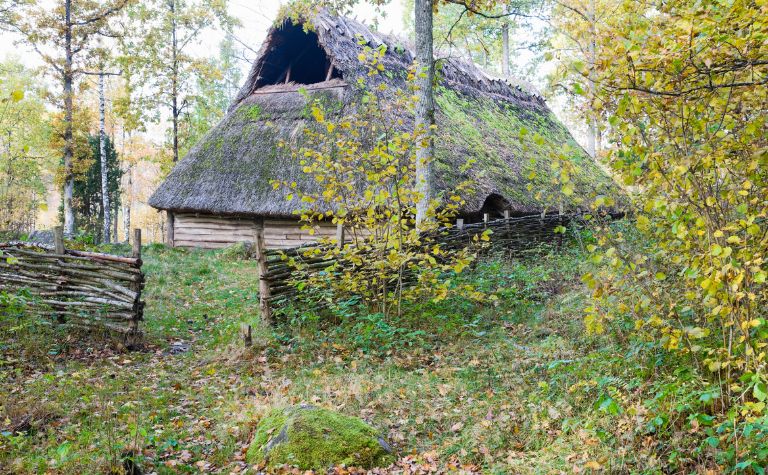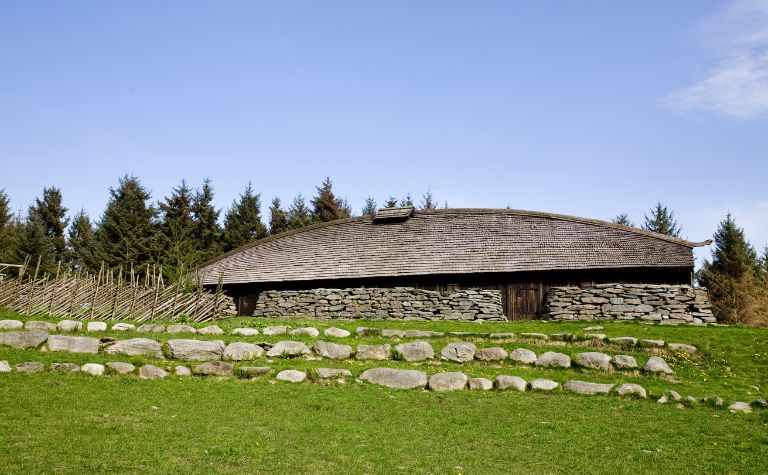Longhouses are one of the most iconic relics of the Viking Age and Norse culture in general.
They’re instantly recognizable, absolutely fascinating, and still garner a lot of attention and many curious questions.
Viking longhouses were large wooden buildings that were home to a few families.
Multiple generations lived under one roof, and there wasn’t much privacy.
Longhouses contained separate rooms for domestic animals. The people tried to make the houses as comfortable as possible and often held feasts.
This article explores the fascinating longhouses of the Viking Age. It presents 11 bite-sized facts that one must know if they’re interested in Norse culture.
Also, see What Did the Vikings Look Like? to learn more.

1. Viking Longhouses Were Made of Wood
Viking longhouses were mainly made of wood, an abundant material that was relatively easy to work with. [1]
The roofs were sometimes covered by tufts, and walls were often lined with clay or mud for additional protection from the cold.
Additionally, straw or moss would be stuffed between the walls for added insulation. [2]
Longhouses were made from planks vertically stuffed into the ground.
There were also internal posts that supported the roof and held the whole building together.
2. They Required Constant Repairs
Viking longhouses had to be repaired very often.
The materials they were made of were often not sturdy enough to withstand harsh weather conditions without sustaining damage.
This was particularly the case in damp areas, where the humidity damaged the wooden walls, which had to be mended.
3. They Were Crowded
The privacy that modern homes allow was not commonplace in the Middle Ages.
It was especially not commonplace in the longhouses, which were mostly populated by more than one family and multiple generations.
Bigger houses often accommodated dozens of people, so they got rather crowded and offered little privacy.
Life was communal, and people lived and worked together, most often in a single room.
4. Vikings Kept Their Domestic Animals Inside With Them
Norse homesteads usually didn’t contain separate buildings for domestic animals such as pigs or cattle.
Instead, there were rooms for those animals inside the houses.
This might seem awfully unhygienic to modern people, but it wasn’t so unusual in medieval Europe.
Also, see How Did Lagertha Die In Vikings? to learn more.

5. They Were Smoky
Norse longhouses did not have chimneys. The smoke escaped through a hole in the roof. This meant the houses were often filled with smoke if the smoke couldn’t escape.
Those holes would also probably cause problems in rainy or snowy weather.
There was usually one big open fireplace used for cooking and keeping warm.
People would often huddle near the fire to keep warm during the long cold Scandinavian nights.
Apart from there being no chimneys, there were also no windows.
This must have made the longhouses very difficult to air out properly, adding to the aroma of smoke lingering inside them.
6. They Were Lighted With Oil Lamps
The lack of windows meant that the only natural light that reached the houses came through the doors.
This was not nearly sufficient, and the people living inside those houses needed artificial light.
For that purpose, they used oil lamps, which were not difficult to procure.
These relied on fish oil or whale oil, which was abundant, considering that there were many fishermen and whalers in those coastal Scandinavian regions.
7. The Vikings Tried To Make Their Houses Comfortable
Despite the harsh living conditions, the Norse who occupied longhouses tried to make the houses as comfortable as possible.
Wooden benches and beds were built next to the walls, and they were covered with skins for warmth, while the pillows were stuffed with feathers for additional comfort.
Richer people would adorn their walls with shields, tapestries, rugs, and other decorations.
Anything that could be used to decorate a longhouse was used to do so.
Plus, this showed that the owner was wealthy and that the house was prestigious.
Also, see 250 Viking Boy Names to learn more.

8. Viking Longhouses Were Havens of Hospitality
A big, long house that can host dozens of people is the perfect place for a feast.
The Norse knew this and used this possibility to the maximum.
Feasts were common, and there were rules on how to behave as a guest and toward guests, contrary to the idea many people have of the Norse as uncultured and rowdy barbarians.
Hospitality was also extended to weary travelers.
Looking for shelter and food on a Norse homestead was normal, and the owner was expected to accept the travelers in his home.
9. They Weren’t Just for Vikings
Strictly speaking, the word “Viking” refers to the fierce seafaring warriors who conducted raids across Europe.
The word comes from the Anglo-Saxon word wīċing, meaning simply “pirate” or “raider.” [3]
This means that not every Norse person was a Viking. Most were common people, farmers, craftsmen, and traders, rather than raiders.
However, longhouses were common dwellings for all of those common Norsemen.
In fact, longhouses were mostly farmhouses, which means that the people inhabiting them were mostly farmers and not fierce warriors.
However, the word “Viking” colloquially designates all Norsemen, whether or not they took part in raids, so the houses were stuck with the name “Viking longhouses”.
Longhouses were also common in Anglo-Saxon England, and they were quite similar to the ones in Scandinavia.
They were also loved by different Germanic peoples across Europe, probably due to their simple design and practicality.
10. Their Sizes Varied, But All Were Long
The longhouses varied in size, but the name definitely isn’t misleading.
On average, they were 16.4 to 23 ft. (5 to 7 meters) wide and 49.2 to 246.1 ft.(15 to 75 meters) long. [4]
Even for today’s standards, that would be a decently-sized house.
With a bit of redecorating, an average longhouse could probably be turned into a decent modern family home.
11. The Largest Discovered Longhouse Is Over 200 Feet Long
The biggest longhouse ever found was excavated in 1983 in Lofort, Norway.
It was most likely a chieftain’s house, and it was initially 220 ft. (67 meters) long.
It was built around 500 AD and upgraded around 700, extending it to 272 ft. (83 meters).
At the site, tourists can visit the Lofotr Viking Museum, which is a reconstruction of the longhouse.
There are several more longhouses in the area waiting to be excavated, so they might find an even longer longhouse!
Also, see 250 Viking Girl Names to learn more.
References:
[1] Source
[2] Source
[3] Source
[4] Source
[5] Source
